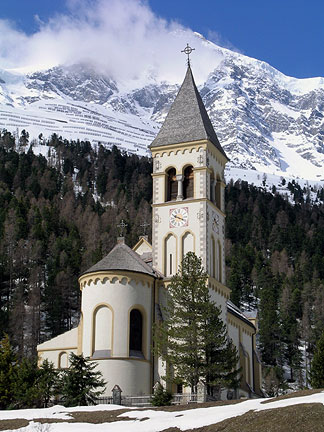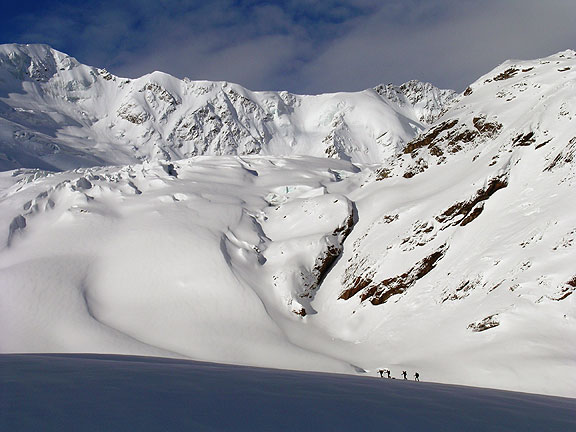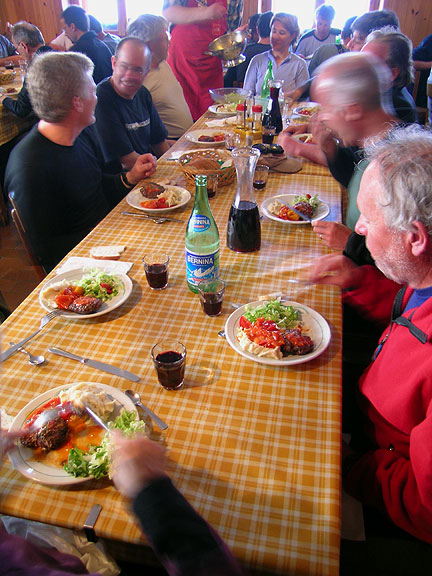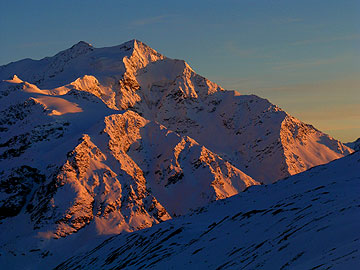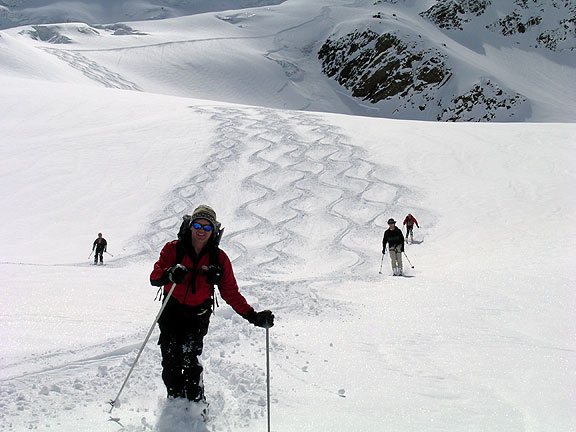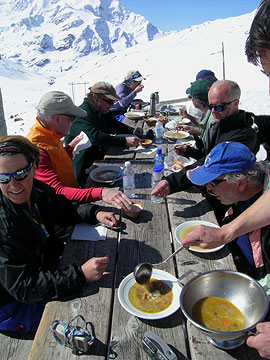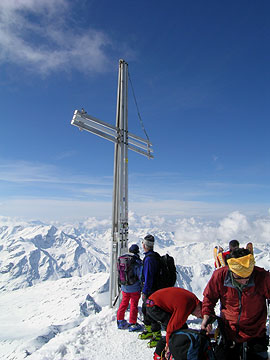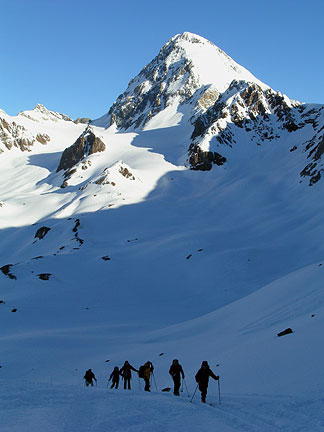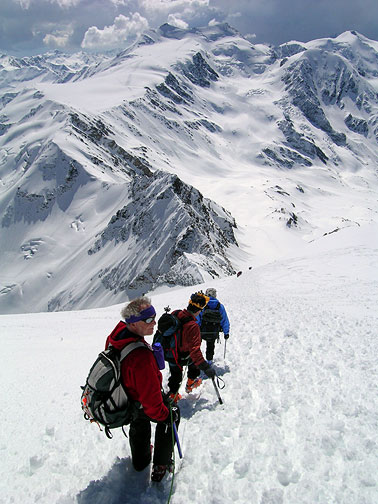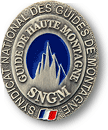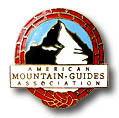 |
|
| Ortler Ski Touring & Ascents |
|
7 days skiing Maximum Group Size See also: |
The Ortler are a group of high peaks nestled between the Bernina group of Saint Moritz to the west and the Dolomites to the east. If you look on a map, you can find the Ortler just south of the point where Italy, Switzerland and Austria come together. The tour lies within the Stilfsejoch National Park, and winds among and occasionally climbs some remarkably high peaks. The fact that several summits come close to the magic number of 4000 meters, but do not quite reach it, both means it is somewhat less crowded than parts of the Alps further west, but also that the terrain is big and high with many large glaciers. And there are several peaks of which we hope to make ski ascents with summits close to 3800 meters. Our tour begins and ends in the ski town of Sulden, following a clockwise circuit, before retuning to Sulden on our 7th day. This tour allows for many potential variations. The most ambitious takes in a number of ski summits, while a milder form forgoes a few of the peaks and concentrates on the fine high touring. If conditions allow, we of course plan on bagging as many great summits as we can (mostly for the sake of the great descents!). The tour is really very adaptable, with easier and harder variations for most days. A small 4:1 ratio allows us to better accommodate varying interests and energy levels within the group. This is one of our favorite tours, a real gem. |
|||||
|
The Ortler are a group of high peaks nestled between the Bernina group of Saint Moritz to the west and the Dolomites to the east. If you look on a map, you can find the Ortler just south of the point where Italy, Switzerland and Austria come together. The tour lies within the Stilfsejoch National Park, and winds among and occasionally climbs some remarkably high peaks. The fact that several summits come close to the magic number of 4000 meters, but do not quite reach it, both means it is somewhat less crowded than parts of the Alps further west, but also that the terrain is big and high with many large glaciers. And there are several peaks of which we hope to make ski ascents with summits close to 3800 meters. Our tour begins and ends in the ski town of Sulden, following a clockwise circuit, before retuning to Sulden on our 7th day. This tour allows for many potential variations. The most ambitious takes in a number of ski summits, while a milder form forgoes a few of the peaks and concentrates on the fine high touring. If conditions allow, we of course plan on bagging as many great summits as we can (mostly for the sake of the great descents!). The tour is really very adaptable, with easier and harder variations for most days. A small 4:1 ratio allows us to better accommodate varying interests and energy levels within the group. This is one of our favorite tours, a real gem. This tour is comparable in difficulty to the Chamonix to Zermatt Haute Route, and those who have enjoyed that tour should be well suited to this one. Most of the summits can also be reached by ski alone and offer fine descents on large glaciers and varied terrain. Much of the tour traverses high glaciers, occasionally crevassed, and there are a few steep sections where good ski control on steep terrain is essential. |
|
||||||||||||||||||||||
|
Ortler Ski Touring Itinerary |
|||||
| Day 0 |
Arrive in Sulden, Italy. Rendezvous is at 5 pm in our hotel. Sulden can be reached by train and bus connections from Venice, Milan or Innsbruck. Public transport is also available from Zurich, though this is a bit longer. |
||||
|
Day 1 |
We begin by riding the gondola, then chair lifts up to over 3100 meters–the only way to begin a high ski tour! From the top of the ski area, at about 3250 meters, we ski down (with a bit of side-stepping) and hop over Passo del Madriccio and enjoy a long descent down into the Marteller valley. We'll plan for lunch or a coffee break at the Zufallhütte before we continue with about 300 meters of skinning up to the Marteller hut at 2610 meters. |
||||
|
Day 2 |
Our goal for this day to is to reach the Branca hut. To get there we must cross over the high ridge near Monte Cevedale. We can either ski more or less directly up the Cevedale Glacier and cross the ridge at its low point near the Casati hut (a good spot for a cappuccino), and descend down to the west and then south to the Branca hut, or for a more ambitious alternative, we can ski up towards the top of Monte Cevedale, descend the Cedec glacier a short way, then make a short but steep skin up to the pass between Cevedale and the nearby Pasquale, descending directly to the Branca from here. A third, and even more ambitious route is to traverse the summit of Palon de la Mare before descending to the hut. If we are are feeling really energetic we can also include a quick ski up the Cima Marmotta at 3330 meters. The descent from this peak is north facing down the Alta Glacier so with a bit of luck we'll have some good cold snow! The Branca is a very fine hut, with great food, wonderful coffee, a good wine selection and hot showers! |
||||
|
Day 3 |
The Branca hut's location at the entrance to a giant cirque of high peaks, all with large glaciers flowing north towards the hut, make it a conveniently situated base from which to do two recommended ski ascents/descents; the Pizzo Tresero at 3594 meters, and the Punta Matteo which is 3678 meters high. We'll make our selection when we get there. |
||||
|
Day 4 |
For our second day of touring out of the Branca hut, we can do whichever of the Tresero or San Mateo peaks we did not do the day before. There are other good ski peaks in the area also, such as the Palon de la Mare, a 3685 meter summit just east of the hut. |
||||
|
Day 5 |
On day 5 we head north to the Pizzini hut, located at 2700 meters in the Cedec valley. This can either be an easy ski up the valley, or a more adventurous (and arduous) ascent over the Pasquale-Cevedale col. The ski route from Pasquale descends the steep Cedec Glacier. Facing northwest, it should hold good snow if we're lucky. |
||||
|
Day 6 |
We plan 2 nights in the Pizzini hut. For the day between, day 6, several options exist. A fine and fun tour leads up to the 2279 meter high Col Pale Rosse, under the steep south face of the Zebru, which offers a long, satisfying ski descent, usually on great corn snow. We return to the Pizzini hut for the night. |
||||
|
Day 7 |
On our last day we climb up, crossing again the provincial border between Lombardia to Alto Adige. We pass the Casati hut and continue north to cross the high Eisseepass, before skiing the fine slopes back into the Sulden ski complex. With a bit of luck we'll be able to ski all the way to town. |
||||
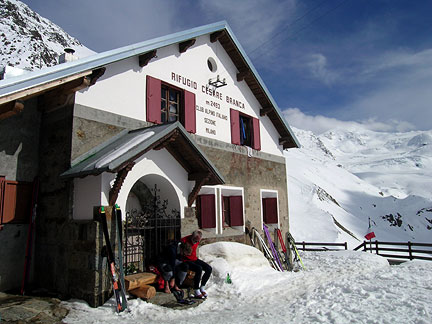 |
|
| The Branca hut. | |
| Skills Required | ||||
|
This
tour requires a high level of fitness and very good to
excellent skiing abilities. On a number of days the total
elevation gained is over 4000 feet. Being in good shape
will ensure you have enough energy to manage (and have
great fun as well!) on the long descents which follow. The
reason that skiing skills must be at an advanced to expert
level has more to do with the conservation and expenditure
of energy over a long day than the absolute technical
difficulty of the skiing. There are a few steep sections,
but for the most part the slopes are not overly steep. The
challenge comes in managing poor snow conditions (heavy
wet snow, crud or breakable crust) and not losing too much
energy or risking injury in the process. Great skiers look
like they are hardly working, and this is in fact the
case. If your skiing is not up to par you will spend far,
far more energy than a better skier.
Ski skills required;
Skiers who regularly enjoy black or double black runs in most western American ski areas should do fine. If you like to get off the piste and into the crud, ski the trees, and in general look for the steeper shots, you'll probably have a great time on this tour. If you tend to stick to the groomed slopes and find the wild untracked a bit intimidating you should think twice about this option. We will likely encounter all different kinds of snow, from the best to the worst, and you need to have sound, energy-efficient strategies to cope with them. A good gauge of your ability can be found in mogul skiing. If you are good in the bumps and seek them out, then you most likely have developed the rhythm and balance needed for steep or difficult snow. You must be able to ski moderate bumps in good conditions, skiing rhythmically and fluidly, following a line near the fall line with good speed control. If you have any doubt about your ability to manage the skiing on this tor, please contact us to see if we can answer your questions. Previous ski touring or mountaineering skills are useful, but not required. If you are a good skier, you will not have difficulty picking up these new skills, as you will already be comfortable on steep slopes. |
||||
|
||||||||
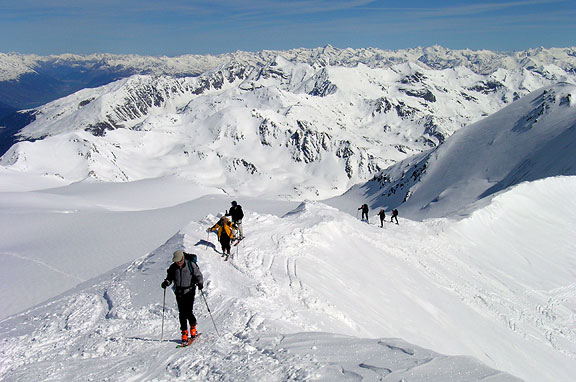 |
|
| Monte Cevedale. | |
|
||||||||
 |
|
| The southern Ortler group from near the Col Pale Rosse. | |
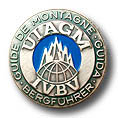 |
Kathy Cosley &
Mark Houston AMGA Certified • SNGM
members All images, layout and text ©2004 Cosley & Houston Alpine Guides, All Rights Reserved |
|
